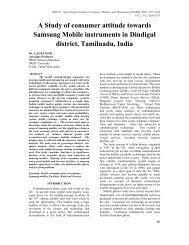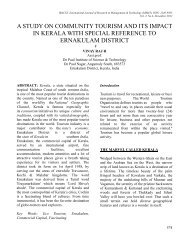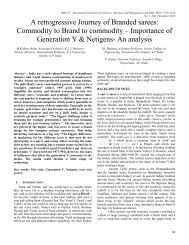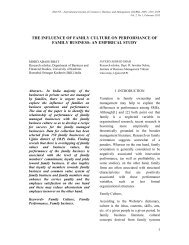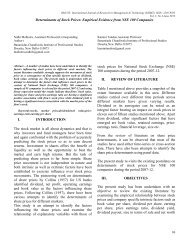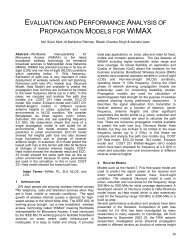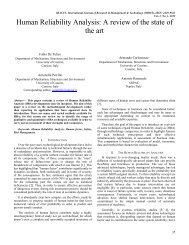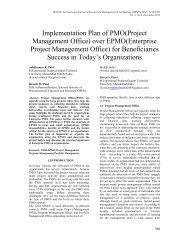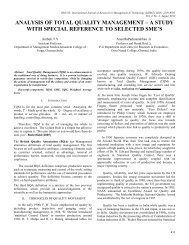Identifying Factors influencing preference towards Post Office ...
Identifying Factors influencing preference towards Post Office ...
Identifying Factors influencing preference towards Post Office ...
You also want an ePaper? Increase the reach of your titles
YUMPU automatically turns print PDFs into web optimized ePapers that Google loves.
IRACST- International Journal of Research in Management & Technology (IJRMT), ISSN: 2249-9563<br />
Vol. 2, No.6, December 2012<br />
Kisan Vikas Patra Scheme has been discontinued<br />
by Government of India w.e.f. 1 st December, 2011<br />
and this does not affect those who already have this<br />
certificate.<br />
II. REVIEW OF LITERATURE<br />
The objective of this study is to explore factors that<br />
influence investors to invest among post office<br />
saving products. The present study examines the<br />
factors that appear to exercise the greatest influence<br />
on the investor decision making. It includes the<br />
factors investigated by previous studies like<br />
sources of investment advice, purpose of<br />
investment, education and occupation. Based on<br />
review of literature study identifies influence of<br />
these factors on post office investors decision<br />
making. In addition to factors extrapolated from<br />
academic sources, study also introduces additional<br />
factors generated through personal interviews that<br />
are supposed to influence the investor decision<br />
making. These factors are suggested by the<br />
professional and contextual sources. These factors<br />
that seem to be <strong>influencing</strong> individual investor are:<br />
criteria of agent selection, motivating features of<br />
post office saving schemes and demotivating<br />
factors. Since respondents’ orientation may be<br />
reflected in their answers, they are asked direct<br />
questions covering all the shortlisted factors.<br />
<strong>Factors</strong> considered by previous studies are as<br />
follows:<br />
1.) Sources of investment advice - NCAER Report<br />
(2011) found that while applying for an IPO,<br />
investors across all income/education categories list<br />
newspapers as the single source of information. Dr.<br />
C. Thilakam and Dr. Ganesan (2012) observed that<br />
respondents have gained knowledge about<br />
saving/investment avenues through business<br />
channels. Sanjay Kanti Das (2011) reveals that for<br />
investment in share market, friends & relatives are<br />
the primary source of information and for insurance<br />
market others like agents and development officers<br />
plays the key role. Advertisement, brokerage firms<br />
and other sources have almost a similar impact for<br />
investment in mutual funds. His study shows that<br />
the association between the source of awareness<br />
and preferred investment avenue is not significant.<br />
Study of Anna A. Merikas, Andreas G. Merikas,<br />
George S. Vozikis, Dev Prasad (2011) concludes<br />
that experienced investors rely mostly on wealth<br />
maximization criteria and they are self-reliant<br />
ignoring inputs of family members, politicians, and<br />
co-workers when purchasing stocks. NCAER<br />
Report (2011) found that a significant number of<br />
investors find the advice of brokers more useful.<br />
The survey reveals that while participating in<br />
mutual funds as well as in the secondary market, a<br />
significant majority depends on the advice given by<br />
intermediaries and friends. Nick Chater, Steffen<br />
Huck and Roman Inderst (2010) find that advice is<br />
ubiquitous in the retail investment market. Trust in<br />
advisors is high, but consumers are often unaware<br />
of potential conflicts of interest. Sharon Collard<br />
(2009) finds that many people may rely on<br />
professional financial advice to make pension<br />
purchase and investment decisions, research from<br />
the UK and Australia has highlighted concerns<br />
about the quality of advice provided to individuals.<br />
Pravin Narayan Mahamuni, Santosh Kalabhau<br />
Apte and Dr. Anand Ganpatrao Jumle (2011)<br />
studied that people get the information regarding<br />
investment opportunities present in the market<br />
from their professional consultant. After that the<br />
available information sources like as, TV ads, web<br />
sites, newspaper, friends, etc.<br />
2.) Purpose of Investment - Haruna Issahaku (2011)<br />
found reasons account for households saving and<br />
investment behaviour are to cope with unexpected<br />
emergencies, buy some assets, pay for predictable<br />
expenses, allow for future consumption, make<br />
provision for retirement, to accumulate enough<br />
funds for investment, employ the teaming<br />
unemployed youth, reap higher returns and luxury.<br />
The World Bank new flagship report (2012) finds<br />
that macroeconomic vulnerability and the resulting<br />
unstable income streams, the risk of<br />
unemployment, and health risks are strong<br />
precautionary motive for savings of Turkish<br />
households. Ms. Babita Yadav and Dr. Anshuja<br />
Tiwari (2012) revealed that majority of the<br />
respondents invest in life insurance for tax benefit,<br />
followed by the risk coverage & saving, premium<br />
charges, security with high return and insurance<br />
services.<br />
3.) Educational Qualification - SK Das (2011) finds<br />
that respondents with education below tenth<br />
standard invested mostly in insurance followed by<br />
banks and property. Respondents with education up<br />
to under Graduate level mostly invested in<br />
insurance products followed by share market,<br />
banks and mutual fund. Respondents with<br />
graduation or above education level invested<br />
mostly in insurance products followed by share<br />
market, banks and mutual funds. His study reveals<br />
that the association between the education and<br />
preferred investment avenue is not significant. In a<br />
NCAER report (2011), it was found that twenty six<br />
per cent of households with more than 15 years of<br />
education prefer to invest in secondary markets.<br />
Most participants in the derivatives market have an<br />
average education between 11 to 15 years. Results<br />
of study of Muhammad Naeem Akhtar, Kashif ur<br />
Rehman, Ahmed Imran Hunjra (2011) indicated<br />
that individual investors with higher educational<br />
qualifications have more intentions for short term<br />
investments as compared to the investors with other<br />
qualifications. The World Bank new flagship report<br />
(2012) discussed that the small group of highly<br />
educated has a saving rate of more than 20 percent,<br />
while the large group of least educated saves about<br />
10 percent. The analysis also shows that the more<br />
551



